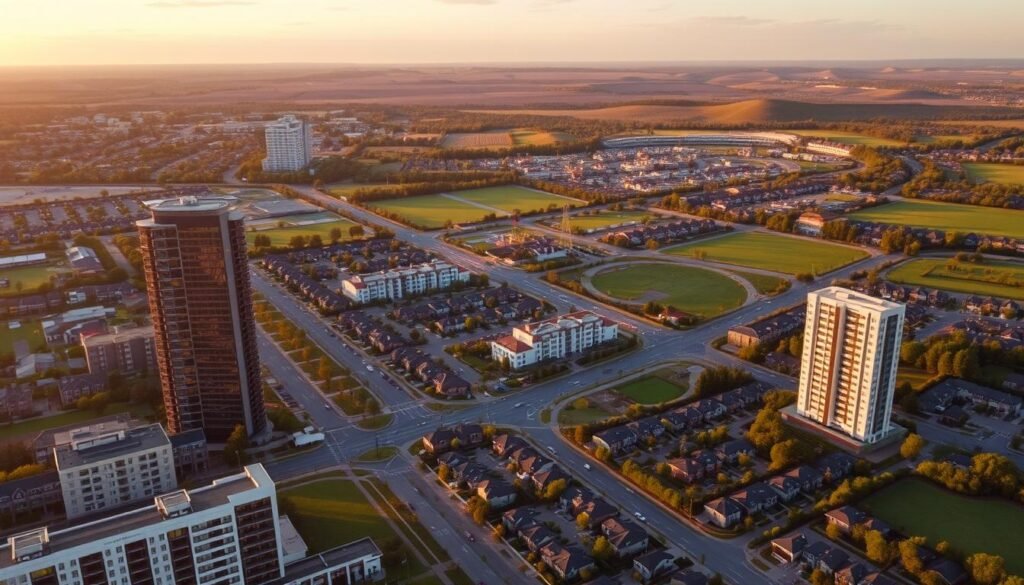
Property Developments USA: Latest Trends, Investments & Market Insights
The USA’s property development scene is always changing. It is driven by different factors that change market dynamics. Now, with a bigger focus on green building, there are new chances for those in real estate. It’s important to understand current trends to find good investment opportunities. This article talks about the newest innovations and hurdles in the US real estate market. It gives a full picture of what’s influencing property developments nationwide.

Key Takeaways
- Property Developments USA are increasingly influenced by sustainable construction practices.
- Market trends highlight a rising interest in green building technologies.
- Investment opportunities are being shaped by emerging regions and urban revitalization.
- Understanding economic factors is crucial for navigating the real estate market.
- Government policies play a significant role in shaping property developments.
- Future prospects include advancements in technology and innovative construction methods.
Introduction to Property Developments in the USA
Getting to know real estate introduction helps you understand how property development overview works in the USA. Property development includes building new places and fixing up old ones. It focuses on homes, businesses, and mixed-use areas. Over time, these projects have changed to meet new economic and social needs.
The USA housing market offers different kinds of homes and spaces for all kinds of people. For example, there are houses for one family, condos, and apartments for many. Office spaces, shops, and factories are also part of this mix. Nowadays, some projects have homes, shops, and offices all in one place, making life easier and promoting togetherness.
Now, people are thinking more about how building projects affect our planet and communities. They consider eco-friendly choices and designs that bring people together more. By looking into these trends, those involved in property developments can stay ahead in the changing scene of the USA’s landscape.
Current Trends in Property Developments
The property development scene in the USA is changing a lot. It’s all about being green and using new tech now. Builders want to make stuff that’s better for the planet and packed with cool tech.
Emphasis on Sustainable Building Practices
Building things in a way that’s good for the earth is big news. People buying houses care a lot about our planet now. So, developers are going all-in on green stuff like saving energy and using stuff that doesn’t hurt the earth.
This move is cutting down pollution and saving folks money in the long run. Buildings that don’t waste so much are becoming a big deal. This makes both the people making the buildings and those buying them very happy.
Technology Integration in Real Estate
New tech is changing how we buy houses. Things like smart homes and virtual looks at houses are just the start. They’re making it easier and cooler to shop for a place to live.
Money tech is making buying homes smoother too, with less hassle. Even the way we pay and get paid for houses is getting an upgrade, thanks to stuff like blockchain. This mix of new tech is really shaking up how we think about building and buying homes.
Popular Regions for Property Developments
The property development scene in the USA is changing. Now, the Southeast is getting noticed for its real estate opportunities. It has strong economic growth and good living conditions. This attracts many people looking for new opportunities. We will look at the top places for property development in this region and urban renewal efforts.
Emerging Markets in the Southeast
Cities in the Southeast are booming. Florida and Georgia, especially, are seeing lots of new residents. This has spiked the need for more homes. Atlanta and Orlando are known for their cool projects and plans for growth. Their nice weather and affordable living costs make them great for investing.
Revitalization of Urban Areas
Urban renewal is breathing new life into old neighborhoods in the Southeast. Cities are upgrading infrastructure and adding amenities. They focus on preserving historical sites and repurposing old buildings. This mix of new and old brings out a special vibe in these areas. It makes people feel more connected to their community.
| City | Key Features | Investment Potential |
|---|---|---|
| Atlanta, GA | Strong job market, diverse economy | High |
| Orlando, FL | Tourism hub, rapid population growth | Moderate to High |
| Tampa, FL | Growing tech sector, waterfront developments | Moderate |
| Charlotte, NC | Financial center, attractive rental markets | High |
Investment Strategies for Property Developments
Understanding different strategies is key to success in real estate investment. For those exploring this field, it’s vital to learn about Real Estate Investment Trusts (REITs), analyze property locations, and diversify investments. These factors can heavily influence your financial results.
Understanding Real Estate Investment Trusts (REITs)
REITs offer a way to earn passive income while diversifying your investment. They gather money from many investors to buy, manage, and sell properties that generate income. Through REITs, investors get regular dividends and reduce their risk by investing in different properties.
This type of investment is more liquid than owning real estate directly, as REITs are traded on major stock markets. This makes it easier for investors to buy in or sell off their investments, helping them maintain a well-balanced portfolio.
Choosing the Right Property Locations
Choosing the right location is critical for property investment success. Look for areas with high demand and potential for growth, as these can offer great returns. Consider factors like population growth, economic development, and nearby amenities when picking a location.
Use market research like checking local sales trends and demographic data. This helps understand a location’s attractiveness now and in the future.
Diversification in Real Estate Investments
Diversifying your investments is a smart move to lessen risks in real estate. It’s wise to spread your investments across different types of properties and locations. This strategy helps safeguard your portfolio against ups and downs in the market.
A mix of residential, commercial, and industrial properties can pave the way for financial success and stability over time.

| Investment Type | REITs | Direct Property Ownership | Diversified Portfolio |
|---|---|---|---|
| Liquidity | High | Low | Medium |
| Passive Income | Yes | No | Varies |
| Investment Control | Low | High | Medium |
| Income Potential | Regular Dividends | Rental Income | Mixed Income |
Impact of Economic Factors on Property Developments
Economic factors play a big role in real estate development. Interest rates, for example, determine how affordable mortgages are. They affect the demand for housing. When interest rates are low, people find it easier to borrow money. This means more people can buy homes, boosting housing development. But, high interest rates might slow things down. They make people think twice about buying due to higher costs.
Interest Rates and Their Influence
Interest rates directly affect how many houses are sold. A small increase in these rates can lead to fewer people applying for mortgages. When fewer people apply for mortgages, builders might put off or downsize their projects. Knowing how interest rates work helps people decide when to invest.
Effect of Inflation on Property Prices
Inflation means costs go up for those building houses. The price of materials and labor rises. So, developers might have to charge more for new homes to still make a profit. This can make houses less affordable. Developers face the challenge of keeping their projects profitable while making sure homes stay affordable.
| Economic Factor | Current Impact | Future Considerations |
|---|---|---|
| Interest Rates | High rates decrease mortgage applications | Potential stabilization as rates adjust |
| Inflation | Increased construction costs | Strategies to mitigate costs |
Property Developments USA: Latest Trends, Investments & Market Insights
The USA’s property developments scene is always changing, showing new trends and smart investments. People are putting money into real estate more creatively now, choosing places that seem likely to grow. They’re also paying more attention to using green methods and new tech, changing the way properties are built and sold.
People in the know are using detailed analyses to make smart choices. This helps pick out markets that are on the up, opening doors to new opportunities. The push for making cities nicer to live in is big, shaping how new properties will look.
Investors should keep an eye on things like interest rates and inflation, as these can greatly affect real estate. Predicting these changes helps make smart, timely decisions that match where the market’s heading. With constant updates, they can get a clearer picture of what investments might bring.

Looking ahead, the future for property development is bright, with a strong focus on being innovative and green. Investors are advised to stay proactive and flexible, making sure their strategies fit with the changing market.
| Trend | Description | Impact on Investments |
|---|---|---|
| Sustainable Building | Focus on eco-friendly materials and practices | Attracts environmentally-conscious buyers |
| Technology Integration | Utilizing smart home technologies and AI | Increases property value and appeal |
| Urban Revitalization | Transforming urban areas into modern living spaces | Boosts demand and property prices in city centers |
The Role of Government Policies in Real Estate
Government policies are key in shaping the USA’s real estate scene. They offer a range of benefits to boost investment in certain areas. This leads to economic growth and area renewal. It’s important for those in real estate to grasp how these policies work.
Incentives for Developers
Incentives are vital in encouraging developers to improve their projects. These include tax credits, grants, and loans with low interest. Such aid lowers costs and boosts local economies by creating jobs and raising property values. Thus, making investments more appealing and profitable for developers.
Building Regulations and Their Impact
Building regulations in the USA ensure safety and environmental protection. They affect design, materials, and construction methods. Following these rules is a must. Ignoring them can result in fines or delays. Knowing local building codes is crucial for launching successful projects.
| Incentive Type | Description | Impact on Developers |
|---|---|---|
| Tax Credits | Reductions in tax liability for qualifying projects | Lower overall project costs |
| Grants | Direct funding for development projects | Increased capital for project execution |
| Low-Interest Loans | Loans with reduced interest rates | Improved financing terms and reduced expenses |
Understanding Market Insights for Property Investors
Learning about market insights can greatly improve how property investors make decisions. A deep dive into market analysis reveals shifts in population trends, changes in prices, and economic factors that affect real estate. This knowledge helps investors understand the complexities of property investments better.
Analyzing Market Data and Trends
Looking closely at market data shows the health and direction of the real estate market. Investors need to pay attention to important aspects like:
- Demographic Trends: Changes in population, where people move, and their earnings affect demand.
- Price Indices: Watching how property values change over time shows if the market is stable or not.
- Economic Indicators: Job rates, salary increases, and how confident people feel relate to the need for housing.
Key Indicators for Future Prospects
Knowing what to look for helps predict what will happen in the property market. Important things to watch include:
| Indicator | Importance | Current Trend |
|---|---|---|
| Rental Yields | Shows how much you could make from property investments | Going up in cities |
| Construction Permits | Tells us about future houses that will be available | More permits being given out in many places |
| Home Sales | Shows how many people are buying homes and the market’s activity | Mostly steady with some ups and downs |
By keeping up with these indicators and examining the right data, investors can guess future market trends better. This helps make smarter choices about property investments.
Challenges Facing Property Developments Today
Today, the real estate development scene in the USA faces many obstacles. These include supply chain issues and not having enough construction workers. These hurdles make it hard for real estate folks to make progress and earn money.
Supply Chain Disruptions
Supply chains have taken a big hit recently, disrupting construction projects. Important materials like wood, steel, and concrete are hard to get and more expensive. This makes developers unsure as they try to deal with changing resource availability.
To handle these issues, developers are looking at different materials and suppliers. They’re working more closely with suppliers to get better deals and delivery times. By being flexible, they hope to lessen the delays and stick to their project plans.
Labor Shortages in Construction
The construction field is really feeling the impact of not enough workers, partly due to changing demographics and rising wages. This makes it tough for companies to find skilled labor, which delays projects and drives up costs. This shortage is a big problem for developers who need to finish projects on time.
As a solution, the industry is trying to bring in new workers. They’re looking at apprenticeships, better training, and improving job benefits. Developers are investing in building a future labor force to tackle these shortages.
Future Outlook for Property Developments in the USA
The landscape of US property developments is changing a lot. Economic factors and what people want are shaping the future of real estate. Looking at current trends can tell us how things are shifting. This is due to more people working from home and changing their lifestyles.
Predicted Market Trends
The real estate world is about to change in many ways. A big trend to watch is the rise of mixed-use developments. These places mix living, shopping, and fun, making life more convenient. They fit well with more people moving to cities. Also, there’s a big move towards eco-friendly properties. This is because people care more about the environment now, which could lead to more green buildings.
Innovations on the Horizon
New building technologies are changing future projects a lot. For example, modular construction could make building faster and cheaper. New materials are also making buildings last longer and be better for the planet. Plus, drones are now key for checking out sites, making sure buildings are up to par. All these new ideas show we’re getting ready for what consumers and investors will need next.
To really get these trends, look at detailed studies. One good source is the housing market outlook. It gives a full picture of where US property developments are heading.
Conclusion
As we wrap up this discussion on property developments in the USA, it’s important to grasp the current trends and hurdles. Key aspects like eco-friendly construction, tech use, and reviving city centers show how innovative this field is. This information is crucial for investors to make smart choices ahead.
Trends suggest the real estate scene will keep changing, influenced by the economy, government rules, and market shifts. For both experienced and new investors, staying updated and flexible is key. This talk offers basic knowledge for strategic investment in promising opportunities.
Being proactive and continuously learning is vital in real estate. With insights on the market and future changes, investors can seize good chances. This way, they can help improve communities nationwide.
FAQ
What are the current trends in property developments in the USA?
Sustainable building practices are more popular now. This includes using materials that are good for the planet and designs that save energy. Also, homes that can be controlled with technology and new finance software are changing how we develop properties.
Which regions are popular for property developments?
The Southeast USA is growing fast because the rules there are helpful and more people are moving in. At the same time, cities are being made nicer. They’re improving roads and places where the community can gather to bring in businesses and residents.
How can investors effectively strategize in property developments?
For passive income, investors should look at Real Estate Investment Trusts (REITs) and also diversify their portfolio. Picking locations where lots of people want to live and spreading investments across different types of properties can reduce risks and increase profits.
What economic factors influence property developments?
Interest rates and inflation trends are big factors. Interest rates change how much people can borrow for mortgages and spend. Inflation affects property prices and the cost of building. Developers need to keep an eye on these factors to plan correctly.
How do government policies affect real estate developments?
Government policies can give developers special benefits, like tax credits, to encourage investing. They also set rules for safety and being eco-friendly, which affects how projects are planned and when they’re finished.
What key market insights should property investors know?
It’s important for investors to study market data, like who’s moving where and the prices of homes. Knowing these facts helps spot where to invest for growth and avoid possible losses.
What challenges are property developments currently facing?
Developers face issues like delays because it’s harder to get supplies, making everything more expensive. There’s also not enough workers, which can slow down projects and affect the work’s quality. Finding ways to bring in more skilled workers is crucial.
What does the future hold for property developments in the USA?
We might see changes like more people working from home, affecting how homes are built. Newer building techniques and materials could also make building faster and better in the future.







